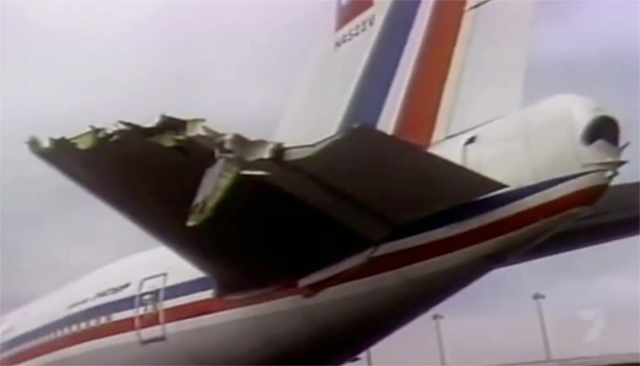Damage to the flight control surfaces
(Or the hydraulics / electronics used to control them)
I'm referring to rudder, ailerons, stabilizers, etc. The big hydraulic surfaces that move into and out of the airstream in order to manoeuvre the aircraft.

(China Airlines flight 006 nearly didn't make it)
The damage needed to cause an absolute emergency situation is usually pretty minimal - you need to at minimum break the smooth airflow over it, but can also remove part of it or lock it in place. It sounds like your looking more for long distance attack rather than a mechanical failure - in which case a few tightly packed bullet holes should cause a secondary failure taking out the majority of the panel, causing a partial loss of control. However if that's not the case mechanical failure or pilot error can also cause it.
Manoeuvring becomes very hard, but with skill and raw determination they can be survived. I think it's just the roll of the dice you want.
Examples (sorted from luckiest to deadliest):
100% survival: A Concorde in 1989 lost part of it's rudder, and they didn't notice until landing in Sydney.
100% survival: 2003 Iraq DHL flight. Another amazing outcome. Missile impacted wing. Total loss of all control. Landed safely (in a minefield) on differential engine power alone.
100% survival: Northwest airlines flight 85. Hydraulic failure caused rudder to lock in hard left in 747. Landed successfully.
70% survival: UA232 in Sioux city Iowa: turbine failure took out rudder hydraulics. Tried to land on differential engine thrust. Failed. Explosive fireball. Cartwheeled down the runway. 112 died. 184 people survived this:

UA232 crash and fireball, and cartwheel. Surprisingly survivable.
50% survival: 4 x 737 rudder hard overs in the 1990s. 2 fell out of the sky and everyone died (United Airlines Flight 585 and USAir Flight 427), at least 2 landed safely (Eastwind Airlines Flight 517 and MetroJet Flight 2710 and possibly more where the cause is suspected but never explained.)
Floor collapsing taking out controls. 20% survival. Turkish Airlines Flight 981 was 100% fatality with 346 died. But when it happened on American Airlines Flight 96 everyone survived.
1% survival: Japan air flight 123. Bulkhead ripped and damaged hydraulics. Plane limped around for nearly an hour before hitting a mountain. 520 died. 4 survived. At least 50 more would've survived if rescuers got there sooner.
0% survival: American Airlines flight 587. Pilot over stressed the rudder and ripped it right off. Everybody died.
-1% 0% survival: American Airlines Flight 191. Detaching engine severed some flight controls, but more importantly disabled the warnings that those controls didn't match. 100% fatality on board (271) + 2 people on the ground.
There's a whole Wikipedia page about this particular failure. Skimming of the list there it looks like the rough odds of survival for this event is about 50%, but it could be argued up (non-notable events aren't mentioned) or down (there are crashes with unknown causes).
